|
Village Radios:
During the Vietnam War the CIA supported the so called "Village Radio Program". By providing village inhabitants with
simple portable transceivers, Vietcong activities should be reported to the authorities.
The CIA commissioned a domestic autority, the "Office Of Public Safety", and so the village radios
also were called OPS- Radios.
Most of the radios were built by Hallicrafters.
In my museum are: HT-1 ,HT-2 FM-1, FM-5 and TR-20.
Only the FM-1 has a nameplate in Englisch and Vietnamese.
Two more unknown Village radios are in the collection:
 ==> click <== ==> click <==
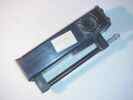 HT-1 : HT-1 :
Channels: 1
Frequency: 30...40 mHz, AM
Crystal controlled
Powered by: 12V ( 8 "D"- cells )
Output power: 0.5 W ( nominal: 1 W )
Consumption (transmitting) : 0.18 A
PC board number: 129-002201
Manufacturer: Hallicrafters
HT-1 came as HT-1A to HT-1E. The first radios had a "Self destruct" button.
Pressing this button together with the PTT, melted a fuse, thus putting the radio out of order.
Whoever had no radio contact any more, had to return to the base at once.
Consequently the radios were "destructed" often, when someone thought to be in danger.
This fuse was substituted by a wire in later models.
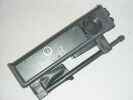 HT-2, HT-2,
Technical data are the same as HT-1, in a small housing screwed to the front of the radio there is an additional
second channel installed :
One Air Radio Channel ( 118 to 130 mHz, AM )
This second channel communicates with Aircraft radios
PC board number: 129-002201
Manufacturer: Hallicrafters
.
( You can switch between: "Air to Ground" and "Ground to Ground").
The HT-2 was used as "Air to Ground"- radio especially in connection with
Delco 5300.
For the description please read::
 HT-2 and Delco 5300 HT-2 and Delco 5300
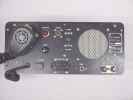 TR-20, "Village" Basestation. TR-20, "Village" Basestation.
TR-20 communicates with HT-1 and HT-2.
Technical data :
Channels: 1
Modulation: AM
Frequency range : 30 ... 40 MHz
Receiver : solid state
Transmitter: Hybrid: Transistor / tube
HF output: 20 W; Switch high/low
Powered by: 12 V or built-in 120V power supply.
Built: 1966 ... 1969
Manufacturer: Hallicrafters
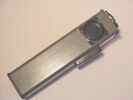 FM-1B: FM-1B:
Channels: 2
Frequency: 148 .. 170 mHz
Modulation: FM
Powered by: 12V ( 8 "A" cells )
PC board number: 129-1476
Manufacturer: Hallicrafters
This radio, though portable,has no built-in antenna. There are many possible antenna options.
We could not find out what the radio was used for.
The collection has two FM-1B (see the picture gallery):
one with namplate in English and Vietnamese
one with nameplate in English only.
The radio is very rare.
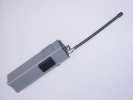 ?? ??
Unknown name, nameplate removed
No data found in the internet
External antenna
1 channel
Power: 12V ( 8 a-cells )
PC board number: 1730-01-(??) (the rest is soldered over)
Manufacturer: most likely Hammarlund
 ?? ??
Unknown name, built by Hammarlund
No data found in the internet
External antenna
1 channel
Power: 12V ( 8 a-cells )
PC board number: 1730-01-(??) (the rest is soldered over)
Manufacturer: Hammarlund
 FM-5: FM-5:
FM-5 is the base station to FM-1.
( The museum shows a prototype ).
Channels: 6
Frequency: 148 .. 170 mHz
Modulation: FM
Powered by: ??
Manufacturer: Hallicrafters
Here, too, we could not find out what the radio was used for.
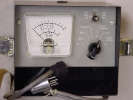 |
TS-210 (test set)
[ < click ]
|
TS-210 is built into a solid, non waterproof, black sheet metal box.
It has two connecting cables: one with a 9-pin connector and one with a 4-pin connector.
The 9-pin connector goes into the tube-like connector on the chassis of the portable radios.
The meaning of the 4-pin connector could not be found out yet.
The test set has no nameplate. There is a production tag that shows :
"Production order 7822" and "Factory 27".

Other radios belonging to "Village-Radios": TR-5 ("Hamlet" Base station; Not in the museum ) and TR-20 ("Village" Base station).
HT-1 and HT-2 communicate with themselves and with TR-5 and TR-20 Base stations.
HT-2, channel 2 communicates with air radios.
FM-1 communicate with themselves and with FM-5 Base stations.
|
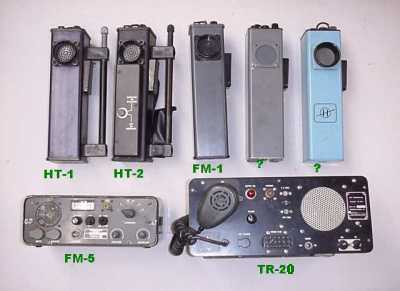
 HT-1
HT-1 HT-2
HT-2 TR-20
TR-20 FM-1B:
FM-1B: ??
?? ??
?? FM-5:
FM-5:
